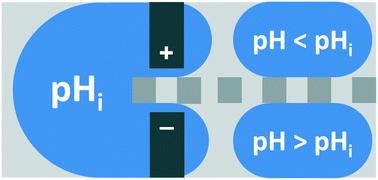Electrochemical pH regulation in droplet microfluidics†
Abstract
We report a method for electrochemical pH regulation in microdroplets generated in a microfluidic device. The key finding is that controlled quantities of reagents can be generated electrochemically in moving microdroplets confined within a microfluidic channel. Additionally, products generated at the anode and cathode can be isolated within descendant microdroplets. Specifically, ∼5 nL water-in-oil microdroplets are produced at a T-junction and then later split into two descendant droplets. During splitting, floor-patterned microelectrodes drive water electrolysis within the aqueous microdroplets to produce H+ and OH−. This results in a change in the pHs of the descendant droplets. The droplet pH can be regulated over a range of 5.9 to 7.7 by injecting controlled amounts of charge into the droplets. When the injected charge is between −6.3 and 54.5 nC nL−1, the measured pH of the resulting droplets is within ±0.1 pH units of that predicted based on the magnitude of the injected charge. This technique can likely be adapted to electrogeneration of other reagents within microdroplets.



 Please wait while we load your content...
Please wait while we load your content...